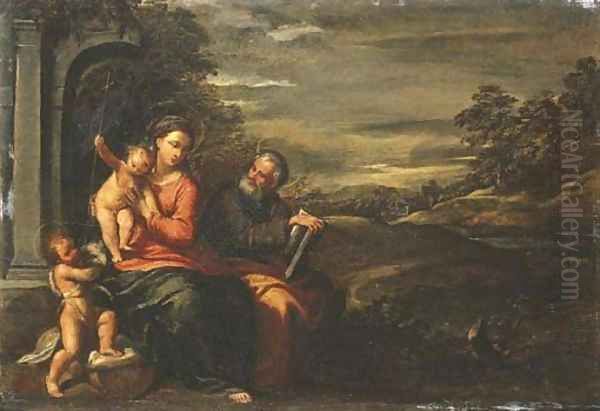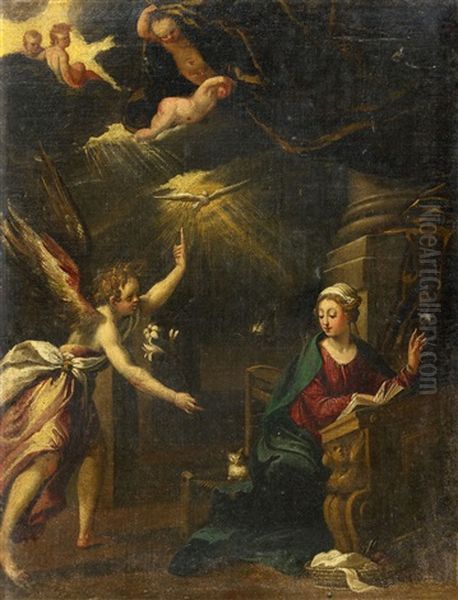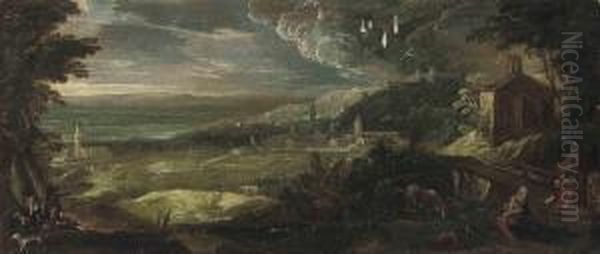Ippolito Scarsella, more widely known by his moniker "Scarsellino," stands as a pivotal figure in the artistic landscape of late sixteenth and early seventeenth-century Italy. Born in Ferrara, likely in 1550 or 1551, and passing away in the same city in 1620 or 1621, Scarsellino's career bridged the waning years of the High Renaissance and Mannerism with the burgeoning Baroque era. His prolific output and distinctive style, a harmonious blend of Ferrarese traditions and Venetian colorism, cemented his reputation as one of the last great masters of the Ferrarese school.
Early Life and Artistic Lineage in Ferrara
Scarsellino was fortunate to be born into an artistic milieu. His father, Sigismondo Scarsella, was himself a painter and architect of some note, though less celebrated than his son would become. It is almost certain that Ippolito received his foundational artistic training from Sigismondo. This paternal tutelage would have immersed him in the rich artistic heritage of Ferrara, a city that had, under the Este dukes, fostered a distinctive school of painting characterized by imaginative, often eccentric, compositions and a particular sensitivity to landscape and atmosphere. Masters such as Cosmè Tura, Francesco del Cossa, Ercole de' Roberti, and later Dosso Dossi and Benvenuto Tisi, known as Il Garofalo, had established Ferrara's artistic identity. Scarsellino would inherit this legacy, particularly the Ferrarese penchant for narrative detail and expressive figures.
The artistic environment of Ferrara during Scarsellino's youth was one of transition. While the grand traditions of the earlier Renaissance masters were still revered, new influences, particularly from Venice and Parma, were beginning to permeate local artistic practice. This dynamic setting provided a fertile ground for a young artist eager to absorb diverse stylistic currents.
The Venetian Sojourn: A Formative Experience

A crucial phase in Scarsellino's development was his period of study and work in Venice. Around the age of seventeen, he is believed to have traveled to the vibrant maritime republic, a powerhouse of artistic innovation. There, he entered the workshop of Paolo Veronese, one of the titans of the Venetian School. This apprenticeship, which reportedly lasted about four years, was profoundly influential. Veronese, celebrated for his opulent, large-scale decorative canvases, his mastery of luminous color, and his grand, theatrical compositions, imparted to Scarsellino a deep appreciation for the Venetian emphasis on colorito (color and painterly application) over Florentine disegno (drawing and design).
Beyond Veronese's direct instruction, the artistic atmosphere of Venice itself was an education. Scarsellino would have been exposed to the works of other Venetian giants. The profound psychological depth and rich, sensuous color of Titian, the dramatic dynamism and intense chiaroscuro of Tintoretto, and the lyrical, often enigmatic, pastoral scenes of Giorgione (though from an earlier generation, his influence persisted) would have all contributed to Scarsellino's evolving artistic vocabulary. The Bassano family, particularly Jacopo Bassano, with their rustic genre scenes, vibrant use of light, and often earthy realism, also likely left an impression, especially in Scarsellino's later incorporation of landscape and everyday details.
Travels and the Absorption of Emilian Influences
After his Venetian sojourn, Scarsellino's artistic education continued with travels to other important artistic centers in Northern Italy. He is known to have spent time in Bologna and Parma, cities with their own strong artistic traditions. In Parma, the legacy of Correggio, with his soft sfumato, graceful figures, and illusionistic dome frescoes, and Parmigianino, a leading exponent of Mannerism known for his elegant, elongated figures and sophisticated compositions, would have offered further stylistic avenues.
Bologna, at this time, was on the cusp of an artistic revolution led by the Carracci family – Ludovico, and his cousins Agostino and Annibale Carracci. Their Accademia degli Incamminati was promoting a return to naturalism and the study of High Renaissance masters, reacting against the perceived artificiality of late Mannerism. While Scarsellino's direct involvement with the Carracci academy is debated, he certainly came into contact with their work and ideas. Later in his career, there is evidence of collaboration, particularly with Ludovico Carracci, reflecting a mutual respect and artistic exchange between the Ferrarese and Bolognese schools.
Return to Ferrara and Mature Artistic Style

Upon returning to Ferrara, Scarsellino established himself as a leading painter, opening a busy workshop. His mature style reflects a masterful synthesis of the diverse influences he had absorbed. From his Ferrarese heritage, he retained a love for intricate detail, expressive figures, and often, a slightly melancholic or poetic mood. From Venice, he brought a richer, more luminous palette, a more fluid brushwork, and a greater sensitivity to the effects of light and atmosphere. The elegance of Parmigianino and the grace of Correggio can also be discerned in the refined features and gentle movement of his figures.
Scarsellino's paintings are often characterized by their intimate scale, even when depicting grand religious or mythological themes. He excelled in creating small, jewel-like cabinet pictures, which were highly sought after by private collectors. His figures are typically graceful and imbued with a gentle humanity. He demonstrated a remarkable ability to convey subtle emotional states through gesture and facial expression. His use of color is often warm and harmonious, with a particular fondness for rich reds, deep blues, and golden yellows, often bathed in a soft, diffused light that creates a serene and contemplative atmosphere.
Themes and Subject Matter: Sacred and Secular
Scarsellino was a versatile artist, adept at handling a wide range of subject matter. Religious themes formed a significant portion of his output. He produced numerous altarpieces for churches in Ferrara and the surrounding region, as well as many smaller devotional paintings for private patrons. These works often depict scenes from the life of Christ, the Virgin Mary, and the saints. His religious paintings are notable for their sincere piety and their ability to engage the viewer emotionally, avoiding excessive theatricality in favor of a more restrained and heartfelt devotion.
Mythological and allegorical subjects also featured in his oeuvre, allowing him to explore classical narratives and showcase his skill in depicting the human form and lush landscapes. These works often possess a lyrical, pastoral quality, reminiscent of Venetian traditions. Furthermore, Scarsellino was a pioneer in the development of landscape painting as an independent genre, or at least as a prominent element within his narrative scenes. His landscapes are not mere backdrops but are often imbued with a poetic sensibility, capturing the play of light and atmosphere with remarkable skill, prefiguring some of the developments of seventeenth-century landscape painting.
Representative Works: A Glimpse into Scarsellino's Artistry
Among Scarsellino's extensive body of work, several paintings stand out as particularly representative of his style and skill.

"The Virgin and Child with the Infant Saint John" is a recurring theme in his work, and these compositions typically showcase his ability to convey tenderness and divine grace. The figures are rendered with soft modeling, and the interaction between them is gentle and intimate. The colors are rich yet harmonious, and the overall mood is one of serene contemplation.
"The Raising of Lazarus" demonstrates his capacity for handling more complex, multi-figure compositions with narrative drama. While maintaining his characteristic elegance, Scarsellino could effectively convey the emotional intensity of such moments, using gesture and expression to articulate the reactions of the onlookers to Christ's miracle.
"The Holy Family with Saint John the Baptist" is another favored subject, allowing for the depiction of familial affection within a sacred context. These works often feature carefully rendered landscape backgrounds, highlighting his skill in this area. Unfortunately, one version of this subject was among the works lost during World War II.
"The Annunciation," a theme he painted multiple times, allowed him to explore the divine encounter between the Archangel Gabriel and the Virgin Mary. These paintings often emphasize Mary's humility and Gabriel's ethereal grace, set within carefully constructed architectural or landscape settings.
Other notable works include "The Martyrdom of Saint Stephen," "The Adoration of the Magi," and "The Flight into Egypt," all of which showcase his narrative abilities, his command of color and light, and his distinctive figural style. His mythological paintings, such as "Venus and Adonis" (another work tragically lost in World War II), demonstrated his engagement with classical themes popular during the Renaissance.
Many of Scarsellino's works are housed in prestigious collections, including the Galleria Borghese in Rome, which holds a significant number of his paintings, attesting to the esteem in which he was held by Roman collectors like Cardinal Scipione Borghese.
Interactions with Contemporaries and Influence
Scarsellino's career unfolded during a period of intense artistic activity and exchange. His relationship with the Carracci, particularly Ludovico, is significant. They are known to have collaborated on projects, such as decorations in the Palazzo dei Diamanti in Ferrara. This interaction suggests a mutual influence, with Scarsellino potentially absorbing some of the Carracci's reformist classicism, while the Carracci may have appreciated Scarsellino's Venetian-inspired colorism and Ferrarese refinement.

He was also a contemporary of other significant artists. In Rome, figures like Cavalier d'Arpino (Giuseppe Cesari) represented a more traditional late Mannerist style, while the revolutionary naturalism of Caravaggio was beginning to send shockwaves through the art world in the final years of the 16th and early 17th centuries. While Scarsellino was not a Caravaggisto, the broader artistic shift towards greater naturalism and dramatic intensity formed the backdrop to his later career. Federico Barocci, working in Urbino and Rome, with his soft, sentimental style and vibrant, almost pastel-like colors, offers another point of comparison for the kind of devotional art popular at the time.
Scarsellino also played a role as a teacher. His workshop in Ferrara trained younger artists, the most notable of whom was Costanzo Cattani. Through his students and the widespread dissemination of his own works, Scarsellino's influence extended beyond Ferrara, contributing to the artistic currents of Emilia-Romagna and the Veneto.
The Ferrarese Context in Decline and Papal Rule
The political and cultural landscape of Ferrara underwent a significant change during Scarsellino's lifetime. In 1598, upon the death of Duke Alfonso II d'Este without a direct heir, Ferrara, which had been a vibrant ducal seat, was absorbed into the Papal States. This transition marked the end of the Este court's lavish patronage that had nurtured the Ferrarese school for generations. While artistic production continued, the city's status as a leading cultural center diminished. Scarsellino, however, remained highly active and sought after, adapting to the new political and ecclesiastical patronage structures. His continued success in this period speaks to his established reputation and the enduring appeal of his art.
Later Years, Legacy, and Posthumous Reputation
Ippolito Scarsella continued to paint prolifically throughout his later years, maintaining a high level of quality and artistic invention. He died in Ferrara in 1620 or 1621, leaving behind a substantial body of work that secured his place as the last great master of the Ferrarese school.
In the centuries following his death, Scarsellino's reputation sometimes suffered from misattributions, with some of his works being ascribed to more famous Venetian masters like Paolo Veronese, a testament, in a way, to the Venetian qualities of his art. However, modern art historical scholarship has done much to clarify his oeuvre and re-establish his significance. His paintings are now prized for their unique blend of Ferrarese intimacy and Venetian splendor, their delicate emotional sensibility, and their often innovative approach to landscape.
The loss of some of his works, such as the two paintings destroyed during World War II, is a poignant reminder of the fragility of artistic heritage. Nevertheless, the surviving paintings in museums and private collections worldwide continue to attest to his skill and artistic vision.
Conclusion: Scarsellino's Enduring Contribution

Ippolito Scarsella, "Scarsellino," was an artist who skillfully navigated the complex artistic currents of his time. He forged a distinctive personal style that honored his Ferrarese roots while embracing the chromatic richness of Venetian painting and the elegance of Emilian masters. His ability to create works of both profound religious sentiment and charming mythological fancy, often on an intimate scale that invited close contemplation, set him apart.
His contribution to landscape painting, imbuing it with a poetic and atmospheric quality, was forward-looking. As a prolific painter, a respected teacher, and a key figure in the late Ferrarese school, Scarsellino left an indelible mark on Italian art. His works continue to be admired for their refined beauty, their gentle emotional resonance, and their masterful synthesis of diverse artistic traditions, securing his legacy as an important and engaging painter of the late Renaissance and early Baroque periods.